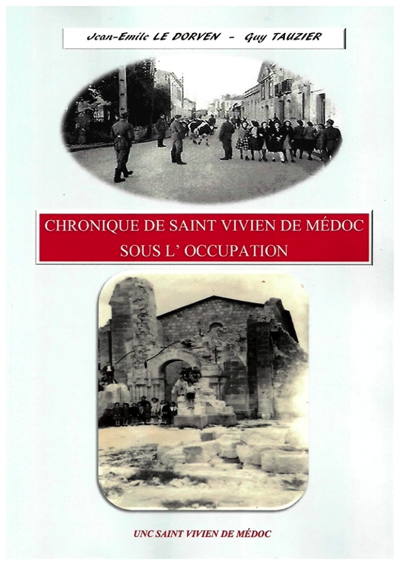Saint Vivien de Médoc under the Occupation

In 2022 the National Union of Combattants of Saint Vivien de Médoc - North Médoc, will celebrate its centenary. Thanks to its unanimously acknowledged social and memorial value it still has 80 members today. Its strength is that everyone, veteran or not, with any memories to pass on, in the broadest sense, is welcome.

In 2011 the UNC of Saint Vivien de Médoc set up its internet site and through this source of communication and information several requests for information about what happened in Saint Vivien between 1940 and 1945 were received. These questions required research and it was impossible to ignore them.
To address this we began by treating our investigations like a police investigation. We searched for evidence from press cuttings, consulting military archives (French and German), departmental (Bordeaux, Metz) and local (Bordeaux, Saint Vivien, Talais). We consulted the local newspapers from that time (Bordeaux library) not forgetting literature about the liberation of the Médoc and many and varied internet sites.
The first enquiry, in 2017, was about the arrest of Henri Lagarde, who farmed the domain of Darrieux in Saint Vivien and died while being deported in 1944. We used French and German archives to work out the circumstances of, and the reason for, his arrest. French and German archives enabled us to find out the circumstances of his arrest. The memorial book of deportees (https://www.bddm.org/liv/omdex_liv.php) helped us reconstruct his transfer from the Fort of Hâ in Bordeaux to the Gros Rosen camp in Poland where he died.
The second request came in 2019 and related to an event which welcomed 10 students from the professional lycée of Reignac (33) to meet witnesses who had seen the arrival of the occupying troops in June 1940. It was a beautiful day of exchanges and memories with recollections of stories lived in Paris, Lyons, Bordeaux, and also Saint Viv”ien and Talais. This meeting was held at the retirement home, “Le repos du marin“ (“The Sailor’s Rest”), in Soulac.
The third request came in 2019 from the grandchildren of Jean-Paul Abel (of Talais). They were seeking information about the death of a Polish soldier who died in Saint Vivien in June 1940. We contacted residents of Talais and Saint Vivien, the mairies of Talais, Saint Vivien and Lesparre, the French military archives at Caen and the German military archives. These various sources enabled us to reconstruct the facts nslations and the time frame. It transpired that there had been a chance encounter between three young people from Talais and a German patrol. The soldiers who had overindulged in a local product were involved in a collision with three young cyclists. As a result one soldier fell and died a few minutes later. Jean-Paul was sentenced to a year in prison. This was served in the fort of Hâ in Bordeaux.
In 2019 the Mairie of Saint Vivien asked us about a Polish soldier who died in Saint Vivien in June 1940. The memories of residents of Saint Vivien let us know why a company of Polish soldiers had been stationed in Saint Vivien and to locate the burial place of a military man at the place known as la Séougue. The military archives at Caen and Metz enabled us to learn about the circumstances and to identify the deceased who was a young sub-lieutenant in the Polish army. The body was removed from Saint Vivien cemetery between 1956 and ? But we found it impossible to determine his final destination. The Polish Embassy in France and the Polish Consulate in Lyon have not replied to our letters.
During our investigations on the Médoc-Actif site we discovered an article, “Some souvenirs of the occupation 1940-45 by Jean-Paul Lescorce” who said that his grandfather, who had refused to leave Saint Vivien, had written what went on day by day and this document is held in his private collection. Jean-Paul Lescorce was happy to lend us the notebook of his grandfather, Gabriel Gautier, and authorised us to copy it as evidence. The contents of this notebook form an integral part of the writing of this book for it was clear to us that it bore witness to the history of Saint Vivien.
In the local archives we had access to the decision of the local council’s documents that enabled us to learn how many refugees from the town of Longwy were welcomed to Saint Vivien and also where they were billeted in Saint.Vivien.
On the Médoc-Actif site we discovered evidence from German prisoners. One of them had worked at “Chateau Dilleman” in Saint Vivien, the other was a junior officer on the boat Z24 of the Narvik batallion. “Medoc-Actif” gave us access to this evidence which showed the situation as seen by these prisoners.
So that’s how the idea of writing the chronicle of Saint Vivien under the occupation became reality by bringing together the results of our research and the contents of Gabriel Gautier’s notebook, an inestimable source and breakthrough.
2022 Jean-Emile Le Dorven / Guy Tauzier (Saint Vivien), translation: Margaret and Richard Beasley